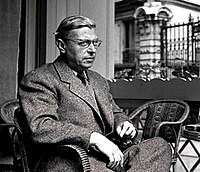Antinovel
[2] However the term "anti-roman" (anti-novel) had been used by Charles Sorel in 1633 to describe the parodic nature of his prose fiction Le Berger extravagant.
Some principal features of antinovels include lack of obvious plot, minimal development of character, variations in time sequence, experiments with vocabulary and syntax, and alternative endings and beginnings.
[1] Although the term is most commonly applied to the French nouveau roman of the 1940s, 1950s and 1960s, similar traits can be found much further back in literary history.
One example is Laurence Sterne's Tristram Shandy, a seemingly autobiographical novel that barely makes it as far as the title character's birth thanks to numerous digressions and a rejection of linear chronology.
[5] To C. P. Snow, the antinovel appeared as "an expression of that nihilism that fills the vacuum created by the withdrawal of positive directives for living", and as an ignoble scene in which "the characters buzz about sluggishly like winter flies".
